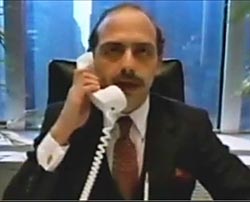conference
Advertising Chiefs Mull Classic Spots
- by Karl Greenberg , May 3, 2012
 At a panel discussion on Thursday at the
New York Public Library, advertising chiefs looked back at classic ads to see how they would play now, and how they would be reinterpreted. The panel, "Taking Advertising Back to the Future" -- part
of The New York Festivals -- looked at five famous TV commercials from the late 1950s to the 1980s.
At a panel discussion on Thursday at the
New York Public Library, advertising chiefs looked back at classic ads to see how they would play now, and how they would be reinterpreted. The panel, "Taking Advertising Back to the Future" -- part
of The New York Festivals -- looked at five famous TV commercials from the late 1950s to the 1980s.
The panel, comprising Diane Ruggie, SVP and Group CD at DDB Chicago, Marty Orzio, CCO at Gotham, N.Y., and Rob Feakins, president and CCO of Publicis New York, looked at VW's "Think Small" (1959); The Pepsi Generation (1963); This Bud's for You (1979); FedEx: Fast Talker (1982); and "Where's the Beef?" (1984).
Would the FedEx talker might now be the "fast tweeter?" Orzio said one obvious reinvention of that spot, where an executive speaks at warp speed throughout his business day, would reflect how such communication is now done: not spoken. "You don't 'hear' from people now, so just the appearance would be different." He said that while FedEx has kept up with that tonality, they don't have the same "conversation" with people.
advertisement
advertisement
Feakins agreed, saying you'd likely now have fast talkers on YouTube and contests to see who could speak faster. "The line the middle of that commercial, about how business exists in 'this fast moving, get it done yesterday world,' is current, and wonders if FedEx could have owned that better in terms of actual utility to navigate a fast-paced world. He also argued that this was also one of the first B-to-B ads that used a very human tone.
Ruggie said the ad reflects how, back in the day, brands knew how to hone their message. "It was about speed and they didn't veer away from that idea. It's so easy to get off the bulls=eye," she said, adding that every idea, app -- everything online has to go back to that core idea.
How about "This Bud's For You?" "We don't do jingles anymore, thank God," said Feakins. "But the notion that they want to be the beer of the people and 'thank you for what you do,' especially when workers of America needed that was strong." He also mulled the idea of how customization could play into the "This Bud's for You," message. Orzio wasn't biting. He argued that it was a basic, self-limiting idea. "I think what it was was they saw their consumer and put music and a tagline on it. I don't think at the time there was much of an idea there."
The original Pepsi Generation spot veered toward a youth positioning, but much more overtly than any brand could do today and get away with it. The spot has a young blond couple on scooter racing up a mountain road with a helicopter flying in a Pepsi vending machine. The voiceover says Pepsi wants to be the top cola for young people, which is why they are everywhere. Tag: "Come Alive! You're in the Pepsi Generation."
"That was at a time when people were very much aware of the generation gap," said Orzio. "During the 80s they turned that youthfulness into a spontaneous or slightly rebellious attitude." He argued that now you'd have to define some part of the younger generation much more clearly and specifically. Feakins said in a weird way that ad has currency for an always-connected social-media-driven world, in that the message is Pepsi will bring you a beverage no matter where we are because it understands its consumers.
"But they'd do a slightly subversive, irreverent viral film now," said Orzio. Ruggie concurred. "It's like what Red Bull does now, with a media house for films. documentaries, and music and putting it into online channels that suit how they have edited it." She said nowadays nobody would say they are targeting a young generation so bluntly. "Back then they had to."
The "Where's the Beef?" ads for Wendy's had three older women trying to ask the supervisor of some McDonald's-like burger chain where the beef was, since the hamburger on their table was miniscule. Does the ad fly now? Orzio said this worked so well because old people say funny things and cut through the noise. "She's a little off kilter, and that's the charm of it. I admire that because the target audience isn't even in the spot -- and how often do we tell ourselves, 'you don't have to put the target in the ad.' Who else but an older woman to tell the truth, that the burger's too small?"
The VW spot, "Think Small" was basically taking a print ad and driving the car onto it. "That philosophy is more current today than ever. They could have been completely about sustainability. They owned some of that.
Orzio said there's something very simple that happens -- "things are only big or small or good or bad relative to something else. They start off by showing a piece of paper and then screw with your perspective. Your expectation is that cars have to be big, so it makes you reexamine the way things have been until that point," he says. "That's a great lesson for anyone coming out with a new product -- to be aware of how people are perceiving [the category]."




